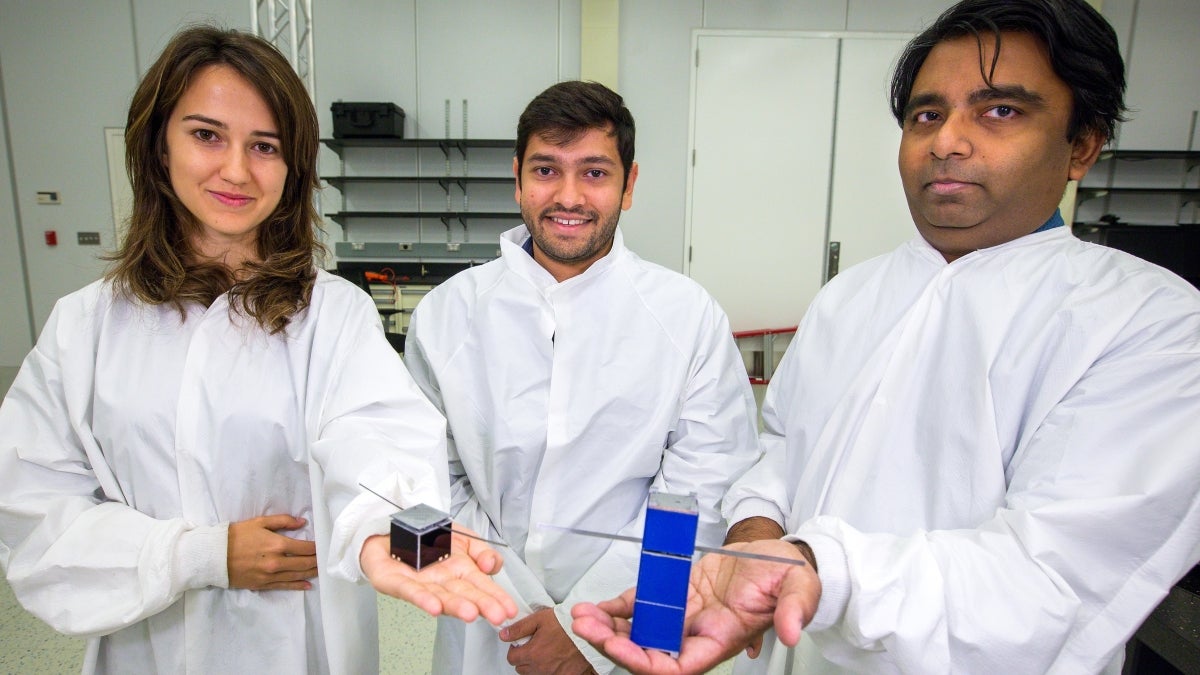ASU satellite wins 2016 Popular Mechanics Breakthrough Award

Jekan Thanga (right), assistant professor in the School of Earth and Space Exploration, worked with a team of students, including graduate aerospace engineering students Mercedes Herreras-Martinez and Aman Chandra, over two years to develop the miniature satellites. Photo by Charlie Leight/ASU Now
ASU’s Space and Terrestrial Robotic Exploration (SpaceTREx) SunCube FemtoSat and the SpaceTREx team, headed by Jekan Thanga, assistant professor with the School of Earth and Space Exploration, have won the Popular Mechanics 2016 Breakthrough Awards in the “Space” category.
The Popular Mechanics Breakthrough Awards recognize innovators and products that have dramatically advanced the fields of technology, medicine, space exploration, automotive design, environmental engineering and more.
This is the first time an ASU project has been awarded a Popular Mechanics Breakthrough Award, beating out MIT, Stanford and Princeton.
The SunCube FemtoSat is a satellite that defines a new standard for a spacecraft. It has a mass of 35 grams, it is tiny — 3 x 3 x 3 cm — and it would cost as little as $1,000 to launch to the International Space Station, or $3,000 as free flier in low Earth orbit.
It is being developed at ASU’s SpaceTREx Laboratory headed by Thanga and ASU students Mercedes Herreras-Martinez, Andrew Warren, Aman Chandra, Laksh Raura and Ravi Nallapu.
The FemtoSat advances a positive vision for the future where space missions are defined not by an elite few, or the hundreds of millions or billions of dollars it costs, but by how they inspire, educate and enable greater access to space.
“Space exploration can advance rapidly once there is widespread interest, adoption and access by a large fraction of humanity, whose skills and talents are required to bring new and innovative thinking to the most pressing challenges in the field,” Thanga said.
Previous award winners in the “Space” category include the University of Arizona for the Phoenix Lander in 2008, NASA Ames LCROSS Lunar Orbiter and Impactor mission in 2010, NASA JPL’s Mars Exploration Rovers in 2011, NASA JPL’s Voyager Missions (for lifetime achievement) in 2012 and NASA Ames LADEE mission in 2014.
The awardees are featured in the October print edition of Popular Mechanics out in newsstands now and on the Popular Mechanics website.
More Science and technology

ASU and Deca Technologies selected to lead $100M SHIELD USA project to strengthen U.S. semiconductor packaging capabilities
The National Institute of Standards and Technology — part of the U.S. Department of Commerce — announced today that it plans to…

From food crops to cancer clinics: Lessons in extermination resistance
Just as crop-devouring insects evolve to resist pesticides, cancer cells can increase their lethality by developing resistance to…

ASU professor wins NIH Director’s New Innovator Award for research linking gene function to brain structure
Life experiences alter us in many ways, including how we act and our mental and physical health. What we go through can even…